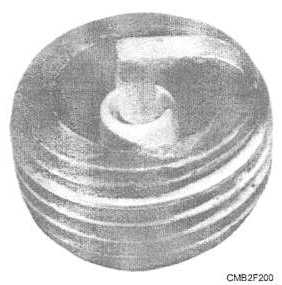programmed to adjust ignition timing based on engine conditions. The computer may be mounted on the air cleaner, under the dash, on a fender panel, or under a seat.
The following is an example of the operation of a computerized advance. A vehicle is traveling down the road at 50 mph; the speed sensor detects moderate engine speed. The throttle position sensor detects part throttle and the air inlet and coolant temperature sensors report normal operating temperatures. The intake vacuum sensor sends high vacuum signals to the computer.
The computer receives all the data and calculates that the engine requires maximum spark advance. The timing would occur several degrees before TDC on the compression stroke. This action assures that high fuel economy is attained on the road.
If the operator began to pass another vehicle, intake vacuum sensor detects a vacuum drop to near zero and a signal is sent to the computer. The throttle position sensor detects a wide, open throttle and other sensor outputs say the same. The computer receives and calculates the data, then, if required, retards ignition timing to prevent spark knock or ping.
IGNITION SYSTEM MAINTENANCE
Ignition troubles can result from a myriad of problems, from faulty components to loose or damaged wiring. Unless the vehicle stops on the job, the operator will report trouble indications, and the equipment is turned into the shop for repairs.
Unless the trouble is known, a systematic procedure should be followed to locate the cause. Remember, that electric current will follow the path of least resistance. Trace ignition wiring while checking for grounds, shorts, and open circuits. Bare wires, loose connections, and corrosion are found through visual inspection.
After checking the system, you must evaluate the symptoms and narrow down the possible causes. Use your knowledge of system operation, a service manual troubleshooting chart, basic testing methods, and common sense to locate the trouble. Many shops have specialized equipment that provide the mechanic a quick and easy means of diagnosing ignition system malfunctions.
Spark Plugs and Spark Plug Wires
Bad spark plugs cause a wide range of problems - misfiring, lack of power, poor fuel economy, and hard starting. After prolonged use, the spark plug tip can become coated with ash, oil, and other residue. The spark plug electrodes can also bum and widen the gap. This makes it more difficult for the ignition system to produce an electric arc between the electrodes.
To read spark plugs closely, inspect and analyze the condition of each spark plug tip and insulator. This will give you information on the condition of the engine, the fuel system, and the ignition system. The conditions commonly encountered with spark plugs areas follows:
NORMAL OPERATION (fig. 2-47) appears as brown to grayish-tan deposit with slight electrode wear. This indicates the correct spark plug heat range and mixed periods of high- and low-speed operation. Spark plugs, having this appearance, may be cleaned, regapped, and reinstalled.
CARBON FOULED (fig. 2-48) appears as dry, fluffy black carbon, resulting from slow operating speeds, wrong heat range (too cold), weak ignition (weak coil, worn ignition cables, etc.), faulty automatic choke, sticking manifold control valve, or rich air-fuel mixture. Spark plugs, having this appearance, may be cleaned, regapped, and reinstalled.
OIL FOULED (fig. 2-49) appears as wet, oily deposits with very little electrode wear, resulting from worn rings, scored cylinder, or leaking valve seals. Spark plugs, having this appearance, may be degreased, cleaned, regapped, and reinstalled.

Figure 2-47. - Normal operation.
Continue Reading